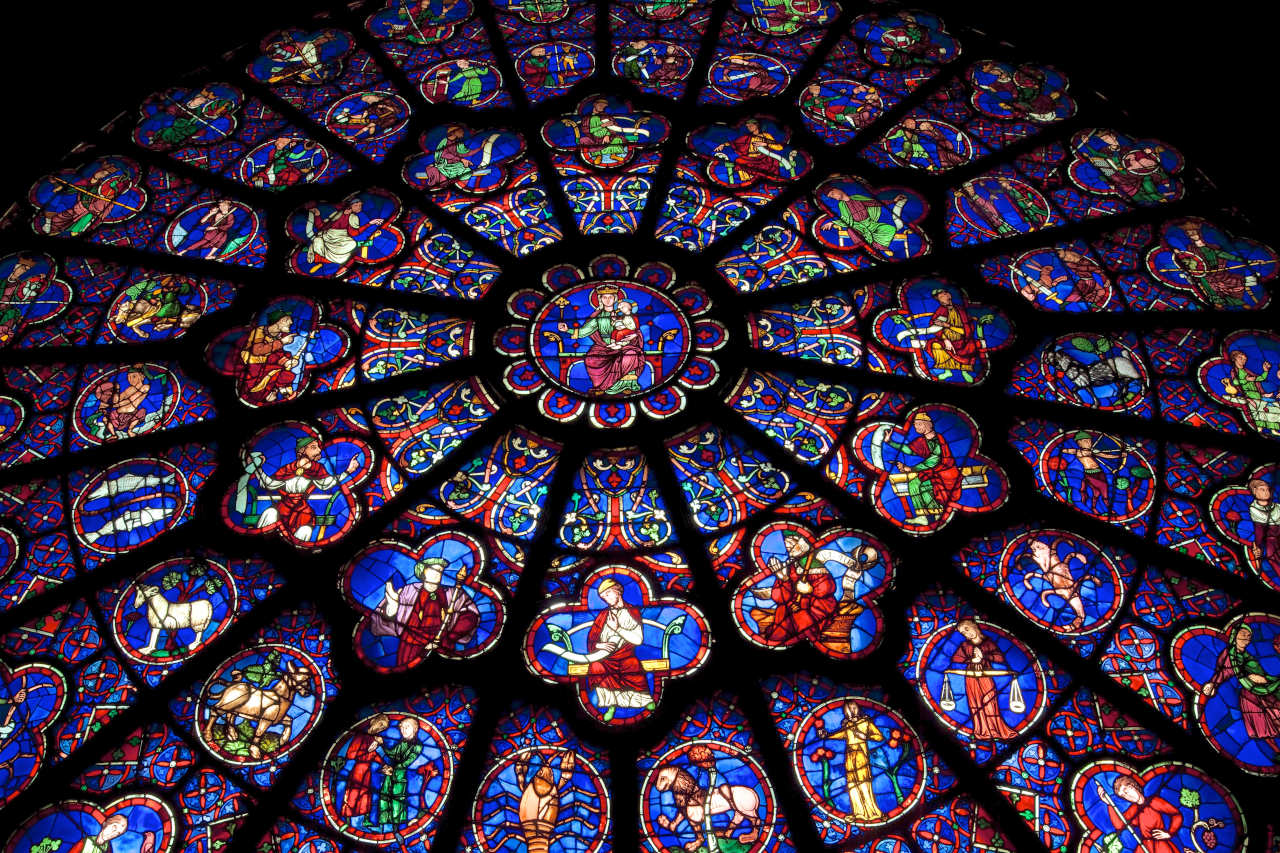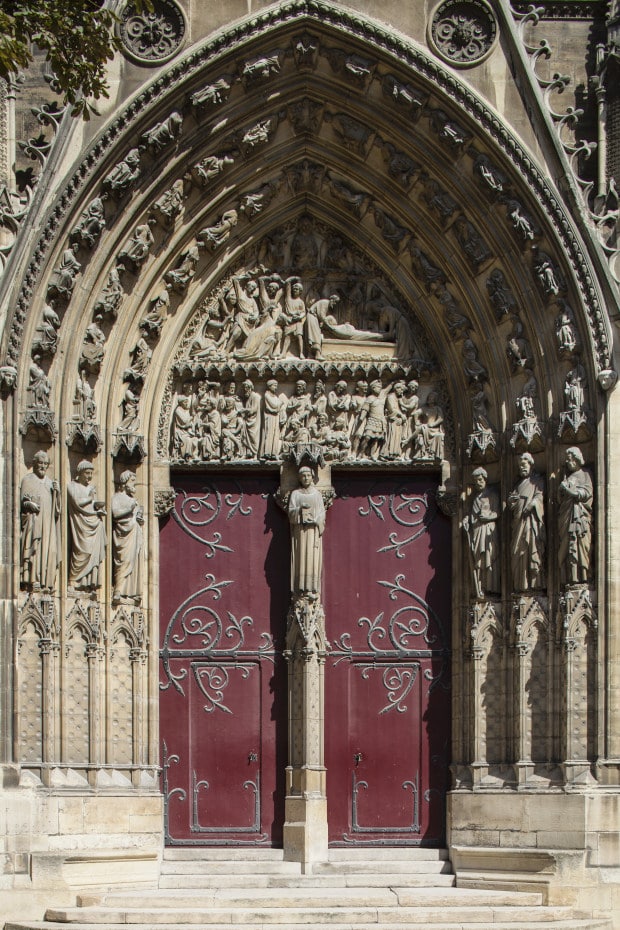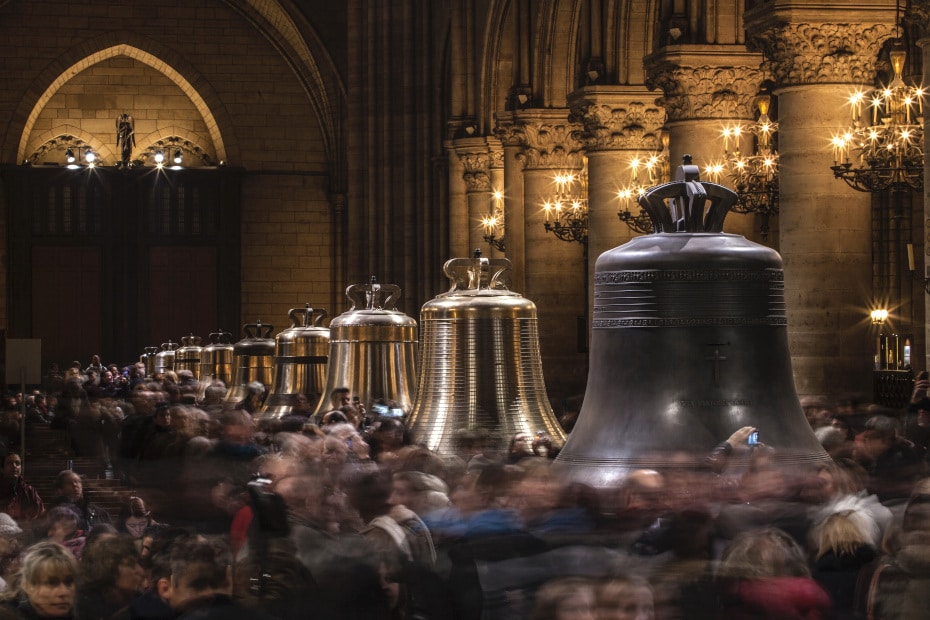Notre-Dame Cathedral boasts three magnificent rose windows over its main portals.
In architecture, the rose (rosette) window is the shape of the openwork bay in the wall, while rose is the name of stained glass. A large circle of glass piercing a wall supporting tons of stone is a characteristically Gothic architectural feat. It is accomplished by crisscrossing the opening with a visually delicate but structurally strong web of stone, which breaks the glass into smaller shapes in a symmetrical way, distributing weight equally across the circle.
Today, the rosettes in the south transept are the best-preserved medieval stained-glass windows. The north and south rose windows follow the same style of glass painting, but with significant color differences. The south rose window boasts more reds, while the north rose window contains more blues. These color differences account for the time of day when the sun hits the cathedral, illuminating its interior in beautiful, colorful hues of light.
South Rose Window
The south rose, also known as the “midday rose”, was given to Notre-Dame Cathedral by the king of France Saint Louis IX. The work of architect Jean de Chelles, then Pierre de Montreuil, it was built in 1260 to echo the north rose window, crafted around 1250. The south rose window measures almost 13 meters in diameter (about 42 feet). Including the frame on which it rests, the total height reaches nearly 19 meters.
The south rose window’s composition has 84 panels spread over four circles with the theme of the Last Judgement. Christ is depicted in the center surrounded by angels and images of the Wise and Foolish Virgins, accompanied by saints, Apostles, bishops, male and female confessors, deacons, female martyrs and knights.
The number of panels is articulated around the symbolic digits 4, 12 and 24. The 12 Apostles are arranged in first two circles. They interact with saints and martyrs often honored in France, such as Denis (the first bishop of Paris), Pothin (bishop of Lyon), Marguerite, Blandine, Georges, Ambroise, and Eustache. The third and fourth circles depict scenes from the New and Old Testaments, like the Flight into Egypt, Healing of a Paralytic, Judgement of Solomon, and Annunciation. Nine scenes from the life of Saint Matthew date from the end of the 12th century. The two spandrels represent on one side the descent into hell, surrounded by Moses and Aaron (above) and the temptation of Adam and Eve (below); on the other side, the resurrection of Christ, with Saint Peter and Saint Paul (below), and Saint Magdalene and Saint John (above).
Since the 15th century, the south rose window has suffered from color stability problems. From 1725 to 1727, Cardinal de Noailles financed its reconstruction and had his coat of arms placed in the center. The master glassmaker Guillaume Brice inlaid old elements there. During the 19th century restorations of Notre-Dame Cathedral, Viollet-le-Duc asked the glassmaker Alfred Gérente to leave these additions. He also reconstructed missing medallions in the style of the Middle Ages, taking inspiration from the stained-glass windows of Chartres Cathedral.
North Rose Window
Sitting directly opposite the south rose window, the north rose window was crafted in the middle of the 13th century around 1250. It is the only rose window to retain its original glass, with most of the 13th century glasswork still intact.
The central image of the north rose window depicts Mary enthroned holding the Christ Child. Surrounding them are images of kings and prophets of the Old Testament, with 16 prophets in the inner circle of medallions and 32 kings and judges in the outer circle.
West Rose Window
The west rose window is found on the front of Notre-Dame Cathedral. Originally completed around 1225, it is the smallest and oldest of the cathedral’s three rose windows, although none of the original glass remains in the frame today.
The west rose window contains 24 rays on three concentric circles. The Madonna and Child dominates the center of the composition. The first circle represents the 12 tribes of Israel. The upper half of the rose depicts the vices and virtues in pairs. The 12 signs of the zodiac associated with the labors of the months of the year cover the lower half of the rose window.



